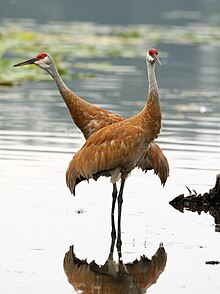
Back Kraanvoël Afrikaans Gruidae AN كركية Arabic كركيه ARZ Gruidae AST Ipom (Gruidae) AVK Durnalar Azerbaijani دورنالار AZB Торналар Bashkir Жураўліныя Byelorussian
| Crane | |
|---|---|

| |
| Sandhill cranes (Antigone canadensis) | |
| Scientific classification | |
| Domain: | Eukaryota |
| Kingdom: | Animalia |
| Phylum: | Chordata |
| Class: | Aves |
| Order: | Gruiformes |
| Superfamily: | Gruoidea |
| Family: | Gruidae Vigors, 1825 |
| Type genus | |
| Grus | |
| Genera | |
|
See text | |
Cranes are a type of large bird with long legs and necks in the biological family Gruidae of the order Gruiformes. The family has 15 species placed in four genera which are Antigone, Balearica, Leucogeranus, and Grus.[1] They are large birds with long necks and legs, a tapering form, and long secondary feathers on the wing that project over the tail. Most species have muted gray or white plumages, marked with black, and red bare patches on the face, but the crowned cranes of the genus Balearica have vibrantly-coloured wings and golden "crowns" of feathers. Cranes fly with their necks extended outwards instead of bent into an S-shape and their long legs outstretched.
Cranes live on most continents, with the exception of Antarctica and South America. Some species and populations of cranes migrate over long distances; others do not migrate at all.[2] Cranes are solitary during the breeding season, occurring in pairs, but during the nonbreeding season, most species are gregarious, forming large flocks where their numbers are sufficient.
They are opportunistic feeders that change their diets according to the season and their own nutrient requirements.[citation needed] They eat a range of items from small rodents, eggs of birds, fish, amphibians, and insects to grain and berries. Cranes construct platform nests in shallow water, and typically lay a clutch of two eggs at a time. Both parents help to rear the young, which remain with them until the next breeding season.[3] Most species of cranes have been affected by human activities and are at the least classified as threatened, if not critically endangered.[4] The plight of the whooping cranes of North America inspired some of the first US legislation to protect endangered species.
- ^ Cite error: The named reference
IOUwas invoked but never defined (see the help page). - ^ Sundar, K.S. Gopi (2009). "Are Rice Paddies Suboptimal Breeding Habitat for Sarus Cranes in Uttar Pradesh, India?". Ornithological Applications. 111 (4): 611–623. doi:10.1525/cond.2009.080032. S2CID 198153258.
- ^ Archibald, George W. (1991). Forshaw, Joseph (ed.). Encyclopaedia of Animals: Birds. London: Merehurst Press. pp. 95–96. ISBN 1-85391-186-0.
- ^ "Species at Risk - Conserving Endangered Cranes". Project Passenger Pigeon. Peggy Notebaert Nature Museum (The Chicago Academy of Sciences). Retrieved 17 August 2022.